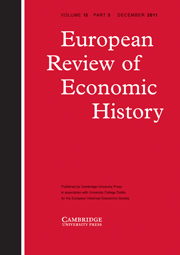Article contents
A new method for estimating the money demand in pre-industrial economies: probate inventories and Spain in the eighteenth century
Published online by Cambridge University Press: 09 October 2009
Abstract
The study of monetary phenomena and an understanding of price determination in modern Europe are too often limited by scarcity of good-quality data sets on the evolution across time of such variables as money holdings, income, or wealth. In this article we show that information contained in probate inventories can be extremely useful in circumventing this problem. In particular, we combine a data set of 116 inventories from Palencia (in northern Spain) between 1750 and 1770 with census information (Catastro de Ensenada) in order to create a cross-section estimate of money demand, a first for any period before the nineteenth century. Results provide meaningful insights about relationships among money demand, wealth, urbanization and structural change in a pre-industrial economy; they also highlight the potential of probate inventories for improving our general understanding of the monetary history of modern Europe.
- Type
- Research Article
- Information
- Copyright
- Copyright © European Historical Economics Society 2009
References
- 7
- Cited by


